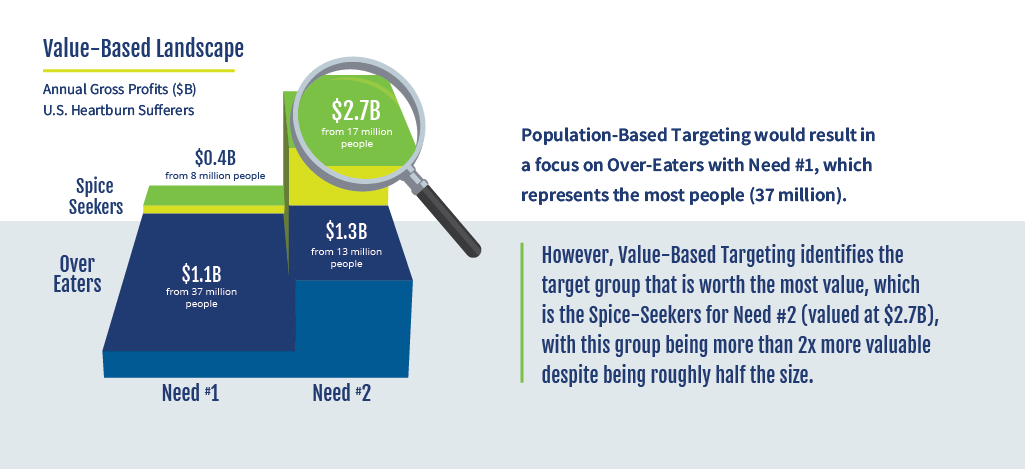
July 1, 2021
Value-Based Targeting: better business-building insight into the most valuable target buyers
Fast-Forward® Market Landscape
7 minute read
When bringing breakthrough innovations to market, a company’s need to manage the risks of uncertainty oftentimes seems at odds with a business leader’s desire to deliver a big and profitable win for the company. No matter the research and development that goes into launching an innovation, there’s always that underlying tension between the company’s need to allocate resources across a portfolio of projects and an innovation team’s desire to get sufficient resources for their project to ensure its success.
One way Big Companies have evolved to offset this tension is through population-based targeting. Population-based targeting uses quantitative research to create a population-based landscape that identifies and sizes potential target buyer segments early in the development process. With the sizing, the Innovation Team can feel confident that they are targeting the buyer pools that give them highest probability of success. While this also provides the company with the confirmation that the target segments are large enough to justify the needed resources, it typically only measures the population of the buyer segments, falling short of measuring whether the segment is valuable enough.
Going Beyond Population-Based Targeting
In the earliest stages of commercializing an innovation, the drawback of the Big Company population-based targeting is that it views all users as equally valuable. But, when resources are in short supply – which is the case with any startup – this “hope” that all buyers are of equal value can be the difference between a thriving Startup and a failed business. Entrepreneurs, worried they can’t keep the lights on at their Startup, simply don’t have the cash to risk on this “hope” and have evolved from the Big Company approach to focus on finding profitable buyers first and foremost and worrying about the segment size later.
The Entrepreneur’s approach skips the pre-launch research and instead they launch with a frantic search for a few buyers who deliver the greatest amount of immediate value for the least amount of costs. They then target buyers with similar attributes and hope there are enough to make them to create a scalable business. Success is connected to finding buyers with those specific traits, and while the lucky may find these attributes, they’ve, in essence, traded one “hope” for another.
Value-Based Targeting (VBT) melds the best of both approaches to break this trade-off and eliminate the reliance on hope. Combining the clarity an Entrepreneur gets on the value that’s being created by individual buyers with the quantification of the potential buyer segments provided by population-based research, VBT leads to a research quantified, Value-Based Landscape. With the Value-Based Landscape, teams get clarity beyond just population, they see how the category’s value breaks down into segments, delivering the deeper insights that ultimately lead to designing better business blueprints to turn the innovation into a successful new business.
Better Business Blueprints Start with Value-Based Targeting
In today’s highly competitive marketplace, teams responsible for launching new businesses should be choosing their target buyer segments with clarity on both the insights gathered from population-based research defining who the segments are and their populations as well as the clarity acquired by value-based methods defining the value of those segments. Using this approach, organizations can more quickly identify segments that have sufficient population AND value to justify the resources needed and the team can feel confident that they’ve identified the right buyer segment and have the deep insights needed to make their initiative a success.
So, how can business leaders successfully deploy value-based targeting?
Here is an example (blinded, it’s not really heartburn, but we’ll use that category to make the example easier to follow) of how a client used VBT to identify the most valuable group of consumers to target and the added insight that came with it.
A company had a novel technology and was trying to determine which consumer segment to target. Using the population-based targeting lens would have led them to target the segment made up of about 37 million people as they represent half of the total population. Given population-based targeting assumes all buyers are of equal value, the traditional assumption would falsely lead teams to believe that means that segment also generates half of the profits.
However, while this group represents about half of the population, they only generate 20% of the potential profits. Using value-based targeting, a smaller but more valuable customer is found. The smaller group would generate more than double the profits at $2.7 billion, even though its population was less than half of the other segment. Importantly, VBT identified that while Need #1 had 50% more buyers (leading to higher concept purchase intent), people with Need #2 placed a significantly higher value on a solution (leading to a lower scoring, but higher value concept because each buyer was worth more). Further, VBT highlighted the insight that target buyers knew when they were going to have a need and could prepare for it (i.e. knew they were making a choice to eat spicy food before they started versus over-eating, which few people choose to do beforehand), enabling the team to better messaging.

While there are other building blocks to also consider (e.g., what is the cost to make a Target Buyer group aware of the new product) when choosing a Target Buyer group for an innovation, having a clear understanding of both the number of people and the value of each person is critical.
Unlocking Upside With Value-Based Targeting
For an organization to quickly unlock the full value of an innovation (e.g. an novel idea, technology, product or service), it’s critical to have clarity beyond the size of the consumer population. With the insights generated through VBT, your organization will have the knowledge you need to create a differentiated business blueprint that ensures the Company’s need for clarity on an opportunity’s size justifies the resources while also ensuring the team gets allocated the resources it needs to make the project a success.
With the clarity VBT delivers, teams can begin creating business blueprints to unlock the value of the segment.
As a first step to determine how Value-Based Targeting could benefit your new business, we’d be happy to schedule a 30-60 minute call to understand your current landscape and how to evolve that into a Value-Based Landscape. To get started simply Contact Us (links to Contact Us page) with some dates/times that would work for you to connect.
VBT is the first phase of the Fast-Forward® process, our proprietary methodology that brings together the strengths of the Big Company and Startup approaches to enable a team to rapidly design and optimize multiple plans to determine the best plan to turn an innovation into a successful business, pre-market.
Key Points:
- The target segment to whom you expect to sell your innovation is a critical building block of any new business.
- Traditional, population-based segmentation creates understanding of the target segment(s) that hold the greatest number of people.
- Using value-based targeting enables you to more quickly identify the target segment(s) that hold the greatest amount of value which directly impacts the near-term fuel for growth and the potential upside for a new business.
- Value-based targeting alone won’t tell you the best segment to target, but it will help you understand if there’s enough value there to justify considering it as a potential target group in one or more business blueprints.
Contact us to learn more about how Fast-Forward® works and how it will help you turn your great idea, technology, product or service into a valuable new business.


